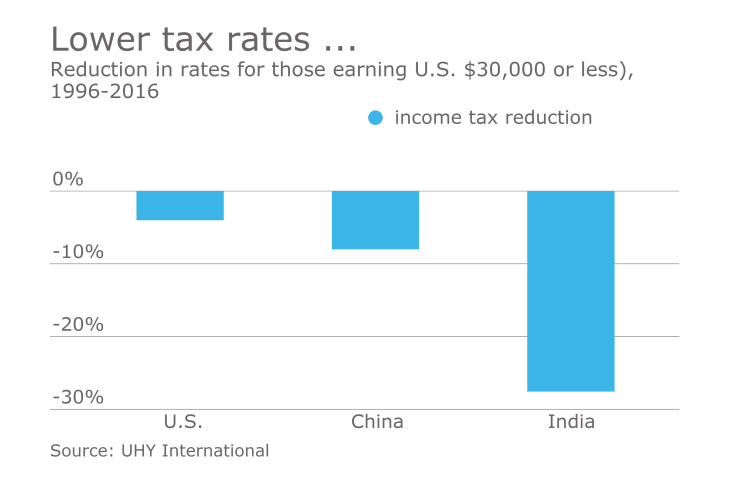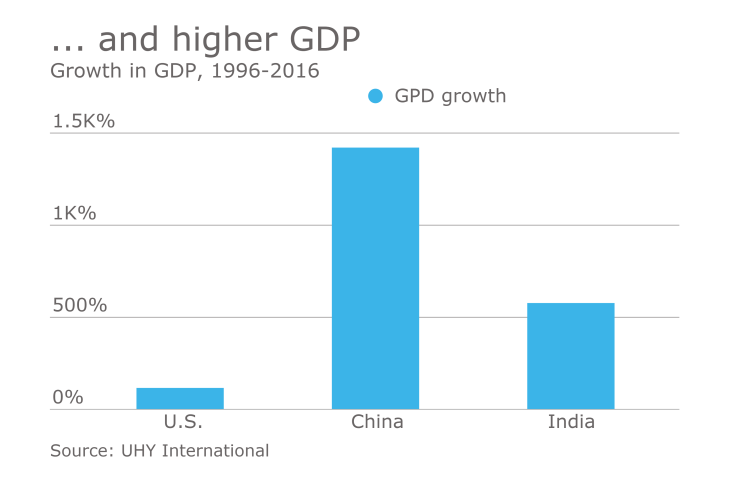Countries that reduce their tax rates over time tend to have higher growth in gross domestic product, according to a new report by Top 50 firm UHY.
U.S GDP has underperformed over the past several decades compared to the global average, at the same time that tax rate reduction has slowed in the U.S., also compared to the global average.


UHY researched these two economic indicators – GDP and tax rates – over the 30 years since the founding of the UHY network, and released the results in a recent report.
“On the whole, U.S. taxpayers have seen little benefit from global reductions in income taxes over that time period,” said Dennis Petri, managing director at UHY. He noted that high-net-worth individuals in the U.S. are among those who have benefited the least from global reductions in income taxes. The effective income tax rate for U.S. taxpayers earning $1 million has fallen at a slower rate (down just two percentage points from 1996 to today) than the global average (down 5.6 percentage points in the last 20 years). U.S. workers on lower incomes – those earning less than $30,000 – have benefitted from more significant tax reductions, with their rates falling by 4 percent, observed Petri.
“Many governments around the world have focused on easing the tax burden on take-home pay in the past 20 years, but the U.S. is not keeping pace with the global average. This risks hampering growth,” he said.
There is a definite correlation, though not necessarily causation, between lower tax rates and higher GDP growth, Petri indicated. “It’s probably a little more complex than [a direct causation],” he said. “While income tax levels are clearly just one factor which could influence growth, there is a correlation nonetheless. For governments everywhere, setting income tax rates at the right level is a delicate balancing act. If they are too high, they can stifle economic growth by reducing consumer spending power and dampening confidence.”
“Among the countries with the highest growth rate in terms of GDP, two stand out very prominently -- China and India,” he said. India has seen the biggest tax cuts of any major economy for lower earners, and their high earners have also seen some of the most significant reductions of any country in the study. Its GDP growth over the last three decades was 577 percent, second only to China‘s growth rate of 1,421 percent, according to the study.
“China’s tax cuts have been far less dramatic, benefitting both lower and high earners equally in terms of the portion of their income paid to the taxman,” Petri said. “With China’s previously strong growth now slowing and its middle class enlarging, it will be interesting to see how its taxation policy develops going forward, as it manages changing domestic and global dynamics.”
The lack of bolder cuts in income tax rates in the U.S. may be a missed opportunity to bolster consumer spending power, improve the country’s attractiveness to an increasingly internationally mobile workforce and boost economic performance,” Petri said. “Such an approach could have contributed more to strengthening the U.S.’s GDP growth in recent decades.”
What’s the point?
With some type of tax reform a distinct likelihood in the months ahead, we may see lower tax rates spurring economic growth. But Tom Giovanetti, president of the Institute for Policy Innovation, cautioned that putting more money in people’s pockets so they can spend it is not the purpose of tax reform.
“No, cash isn’t enough,” he said in IPI’s Tax Bytes. “It has to be invested productively in order to grow the economy by building new buildings, buying new equipment, investing in R&D, and other types of business expansion. When businesses expand, they hire new workers and create new wealth. And that’s what we want.”
Although there is plenty of cash sitting around, it is not being invested productively, he observed. The reason that cash is not currently being invested productively is that the high rate of taxation on capital affects the risk and reward ratio, making investments less attractive,” he said.
“A business is more likely to invest with a potential 20 percent return than it is with a potential 5 percent return. That’s why, right now, lowering the corporate income tax is the best thing the federal government can do to stimulate economic growth.”





